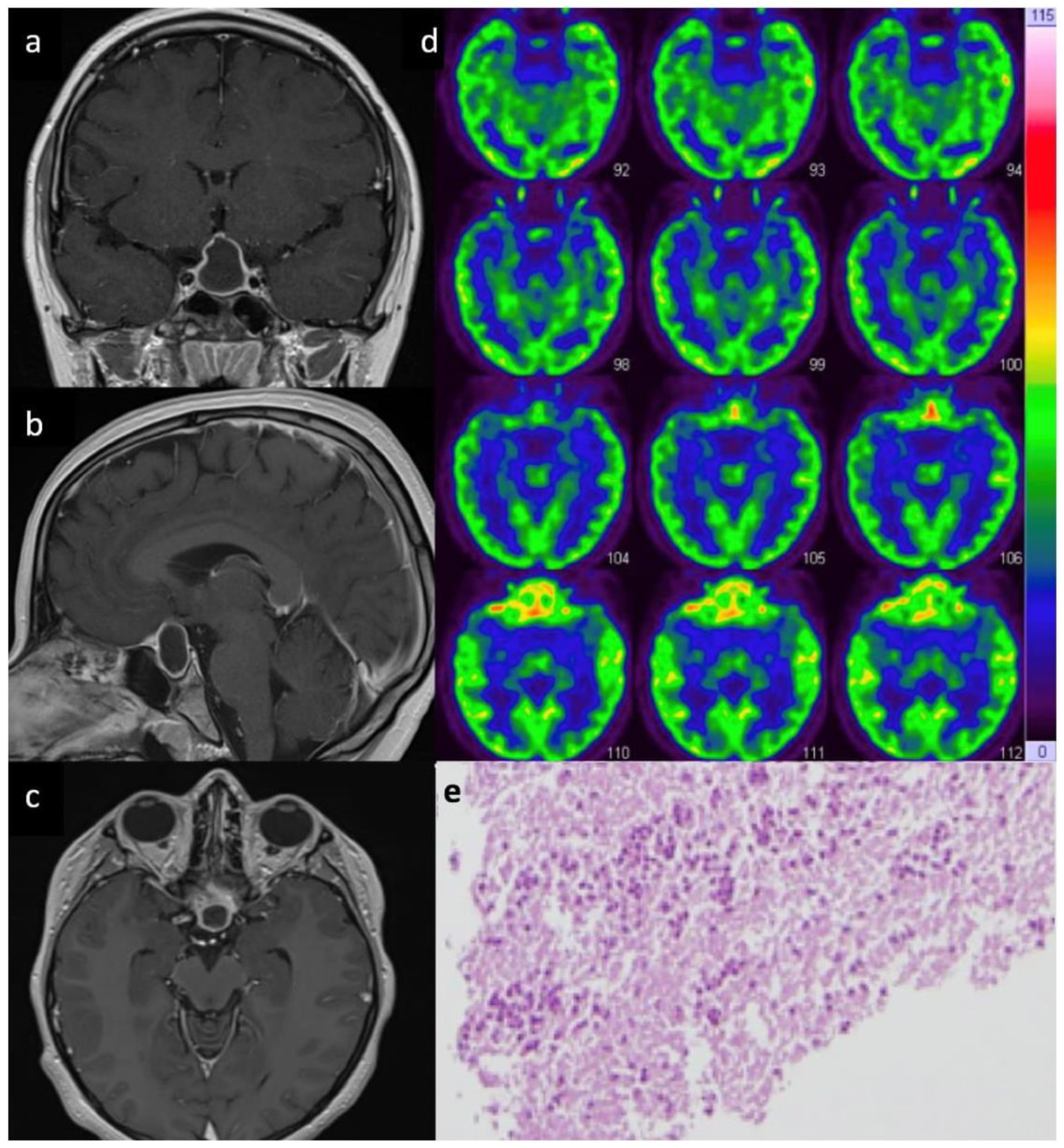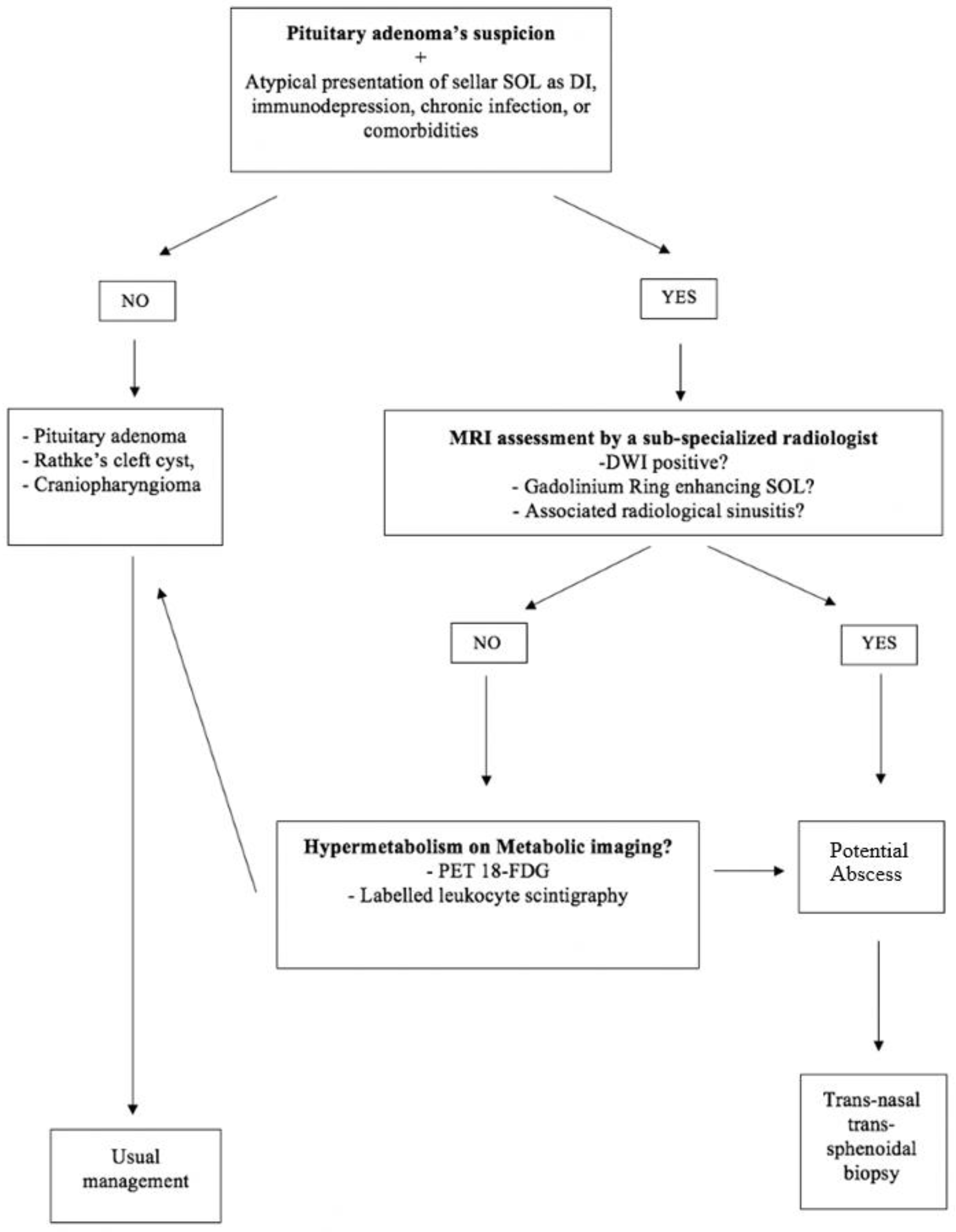Pituitary Abscess: A Challenging Preoperative Diagnosis—A Multicenter Study
Abstract
1. Introduction
2. Patients and Methods
3. Results
3.1. Population
3.2. Clinical Manifestations
3.3. Infectious Syndrome
3.4. Radiological Features
3.5. Bacteriological and Histological Analysis
3.6. Management
3.7. Outcome
4. Discussion
4.1. Results and Outcome
4.2. Pathophysiological Mechanism
4.3. Perspectives
4.4. Study Limitation and Strength
5. Conclusions
Author Contributions
Funding
Institutional Review Board Statement
Informed Consent Statement
Data Availability Statement
Conflicts of Interest
References
- Liu, Y.; Liu, F.; Liang, Q.; Li, Y.; Wang, Z. Pituitary abscess: Report of two cases and review of the literature. Neuropsychiatr. Dis. Treat. 2017, 13, 1521–1526. [Google Scholar] [CrossRef] [PubMed]
- Awad, A.J.; Rowland, N.C.; Mian, M.; Hiniker, A.; Tate, M.; Aghi, M.K. Etiology, prognosis, and management of secondary pituitary abscesses forming in underlying pituitary adenomas. J. Neuro-Oncol. 2013, 117, 469–476. [Google Scholar] [CrossRef]
- Vates, G.E.; Berger, M.S.; Wilson, C.B.; El Malik, E.F.B.; Manoranjan, B.; Ajani, O.; Zidan, A.; Wang, Z.; Gao, L.; Zhou, X.; et al. Diagnosis and management of pituitary abscess: A review of twenty-four cases. J. Neurosurg. 2001, 95, 233–241. [Google Scholar] [CrossRef] [PubMed]
- Aranda, F.; García, R.; Guarda, F.J.; Nilo, F.; Cruz, J.P.; Callejas, C.; Balcells, M.E.; González, G.; Rojas, R.; Villanueva, P. Rathke’s cleft cyst infections and pituitary abscesses: Case series and review of the literature. Pituitary 2021, 24, 374–383. [Google Scholar] [CrossRef] [PubMed]
- Altaş, M.; Serefhan, A.; Silav, G.; Çerçi, A.; Coskun, K.K.; Elmacı, I. Diagnosis and management of pituitary abscess: A case series and review of the literature. Turk. Neurosurg. 2013, 23, 611–616. [Google Scholar] [CrossRef]
- Agyei, J.O.; Lipinski, L.J.; Leonardo, J. Case Report of a Primary Pituitary Abscess and Systematic Literature Review of Pituitary Abscess with a Focus on Patient Outcomes. World Neurosurg. 2017, 101, 76–92. [Google Scholar] [CrossRef]
- Machado, M.J.; Ramos, R.; Pereira, H.; Barbosa, M.M.; Antunes, C.; Marques, O.; Almeida, R. Primary pituitary abscess: Case report and suggested management algorithm. Br. J. Neurosurg. 2021, 1–4. [Google Scholar] [CrossRef]
- Agha, R.; Abdall-Razak, A.; Crossley, E.; Dowlut, N.; Iosifidis, C.; Mathew, G.; Beamishaj; Bashashati, M.; Millham, F.H.; Orgill, D.P.; et al. STROCSS 2019 Guideline: Strengthening the reporting of cohort studies in surgery. Int. J. Surg. 2019, 72, 156–165. [Google Scholar] [CrossRef]
- Jain, K.C.; Varma, A.; Mahapatra, A.K. Pituitary abscess: A series of six cases. Br. J. Neurosurg. 1997, 11, 139–143. [Google Scholar] [CrossRef]
- Shkarubo, A.N.; Chernov, I.V.; Pronin, I.N.; Agrba, S.B.; Andreev, D.N.; Sinelnikov, M.Y. Primary Sellar Abscesses: A Systematic Review and 2 Rare Observations. World Neurosurg. 2021, 154, 21–28. [Google Scholar] [CrossRef]
- Wang, L.; Yao, Y.; Feng, F.; Deng, K.; Lian, W.; Li, G.; Wang, R.; Xing, B. Pituitary abscess following transsphenoidal surgery: The experience of 12 cases from a single institution. Clin. Neurol. Neurosurg. 2014, 124, 66–71. [Google Scholar] [CrossRef] [PubMed]
- Dalan, R.; Leow, M.K.S. Pituitary abscess: Our experience with a case and a review of the literature. Pituitary 2007, 11, 299–306. [Google Scholar] [CrossRef] [PubMed]
- Liu, F.; Li, G.; Yao, Y.; Yang, Y.; Ma, W.; Li, Y.; Chen, G.; Wang, R. Diagnosis and management of pituitary abscess: Experiences from 33 cases. Clin. Endocrinol. 2010, 74, 79–88. [Google Scholar] [CrossRef]
- Al Salman, J.M.; Agha, R.A.M.B.A.; Helmy, M. Pituitary abscess. BMJ Case Rep. 2017, 2017, bcr-2016-217912. [Google Scholar] [CrossRef]
- Dutta, P.; Bhansali, A.; Singh, P.; Kotwal, N.; Pathak, A.; Kumar, Y. Pituitary abscess: Report of four cases and review of literature. Pituitary 2006, 9, 267–273. [Google Scholar] [CrossRef]
- Shimamura, N.; Ogane, K.; Takahashi, T.; Tabata, H.; Ohkuma, H.; Suzuki, S. Pituitary Abscess Showing High Uptake of Thallium-201 on Single Photon Emission Computed Tomography. Case Report. Neurol. Med. -Chir. 2003, 43, 100–103. [Google Scholar] [CrossRef]
- Maartens, N.F.; Ellegala, D.B.; Lopes, M.B. Pituitary abscess. J. Neurosurg. 2001, 95, 1110–1112. [Google Scholar]
- Huang, K.T.; Bi, W.L.; Smith, T.R.; Zamani, A.A.; Dunn, I.F.; Laws, E.R. Intrasellar abscess following pituitary surgery. Pituitary 2015, 18, 731–737. [Google Scholar] [CrossRef]
- Cabuk, B.; Caklılı, M.; Anık, I.; Ceylan, S.; Celik, O.; Ustün, C. Primary pituitary abscess case series and a review of the literature. Neuro Endocrinol. Lett. 2019, 40, 99–104. [Google Scholar] [PubMed]
- Gao, L.; Guo, X.; Tian, R.; Wang, Q.; Feng, M.; Bao, X.; Deng, K.; Yao, Y.; Lian, W.; Wang, R.; et al. Pituitary abscess: Clinical manifestations, diagnosis and treatment of 66 cases from a large pituitary center over 23 years. Pituitary 2016, 20, 189–194. [Google Scholar] [CrossRef]
- Furnica, R.M.; Lelotte, J.; Duprez, T.; Maiter, D.; Alexopoulou, O. Recurrent pituitary abscess: Case report and review of the literature. Endocrinol. Diabetes Metab. Case Rep. 2018, 2018, 17-0162. [Google Scholar] [CrossRef]
- Kawano, T.; Shinojima, N.; Hanatani, S.; Araki, E.; Mikami, Y.; Mukasa, A. Atypical pituitary abscess lacking rim enhancement and diffusion restriction with an unusual organism, Moraxella catarrhalis: A case report and review of the literature. Surg. Neurol. Int. 2021, 12, 617. [Google Scholar] [CrossRef] [PubMed]
- Chibbaro, S.; Signorelli, F.; Milani, D.; Cebula, H.; Scibilia, A.; Bozzi, M.; Messina, R.; Zaed, I.; Todeschi, J.; Ollivier, I.; et al. Primary Endoscopic Endonasal Management of Giant Pituitary Adenomas: Outcome and Pitfalls from a Large Prospective Multicenter Experience. Cancers 2021, 13, 3603. [Google Scholar] [CrossRef] [PubMed]
- Treiber, J.M.; White, N.S.; Steed, T.C.; Bartsch, H.; Holland, M.; Farid, N.; McDonald, C.R.; Carter, B.S.; Dale, A.M.; Chen, C.C. Characterization and Correction of Geometric Distortions in 814 Diffusion Weighted Images. PLoS ONE 2016, 11, e0152472. [Google Scholar] [CrossRef]
- Spinelli, F.; Sara, R.; Milella, M.; Ruffini, L.; Sterzi, R.; Causarano, I.R.; Sberna, M. Technetium-99m hexamethylpropylene amine oxime leucocyte scintigraphy in the differential diagnosis of cerebral abscesses. Eur. J. Nucl. Med. 2000, 27, 46–49. [Google Scholar] [CrossRef]
- Liberatore, M.; Drudi, F.M.; Tarantino, R.; Prosperi, D.; Fiore, V.; Missori, P.; Venditti, M.; Delfini, R. Tc-99m Exametazime-Labeled Leukocyte Scans in the Study of Infections in Skull Neurosurgery. Clin. Nucl. Med. 2003, 28, 971–974. [Google Scholar] [CrossRef]
- Ganau, M.; Syrmos, N.C.; D’Arco, F.; Ganau, L.; Chibbaro, S.; Prisco, L.; Ligarotti, G.K.I.; Ambu, R.; Soddu, A. Enhancing contrast agents and radiotracers performance through hyaluronic acid-coating in neuroradiology and nuclear medicine. Hell J. Nucl. Med. 2017, 20, 166–168. [Google Scholar] [CrossRef] [PubMed]


| Characteristics | Patients n = 84 |
|---|---|
| Sex ratio (M/F) | 0.61 |
| Mean age (years) | 44 |
| Mean diagnosis delay (months) | 9.2 |
| Main symptoms (%) | |
| Asthenia | 75 (63/84) |
| Headache | 50 (42/84) |
| Visual disturbance | 71 (60/84) |
| Endocrinological dysfunction | 73 (61/84) |
| Infectious context (%) | |
| Fever | 8 (7/84) |
| Hyperleucocytosis | 3.5 (3/84) |
| Germs isolated | 25 (21/84) |
| MRI enhanced a (%) | 100 (84/84) |
| Diagnosis suspected (%) | 9.5 (8/84) |
| Outcome at 24 months (%) | |
| Persistant headache | 0 (0/84) |
| Persistant minimal visual disturbance | 12.5 (4/32) |
| Persistant hormonal deficit | 77 (47/61) |
| Persistant diabetes insipidus | 48 (10/21) |
| Persistant radiographic lesions | 14 (12/84) |
| Abscess recurrence | 3.5 (3/84) |
| Clinical Presentation | Patients (n = 84) |
|---|---|
| General % | |
| Asthenia | 75 (63/84) |
| Headache | 50 (42/84) |
| Visual disturbance % | 71 (60/84) |
| Bitemporal hemianopsia | 38 (32/84) |
| Visual impairment | 31 (26/84) |
| Oculomoteur paralysis | 2 (2/84) |
| Preop Anterior pituitary insufficiency % | 73 (61/84) |
| Panhypopituarism | 46 (28/61) |
| Isolated CI | 13 (8/61) |
| Isolated TI | 10 (6/61) |
| Combined CI and TI | 16 (10/61) |
| Combined CI and GI | 6 (4/61) |
| Isolated GI | 8 (5/61) |
| Sexual dysfunction | 8 (7/84) |
| Diabetes insipidus | 25 (21/84) |
| Fever | 8 (7/84) |
| Permanent Hormonal Replacement | |||
|---|---|---|---|
| Preoperative Characteristics | OR | p Value | |
| Women (%) | 30/47 (63.8%) | 1.32 (0.32, 5.21) | 0.65 |
| Anterior pituitary insufficiency (%) | |||
| 1 insufficiency | 17/47 (36.2%) | 3.34 (0.63, 34.27) | 0.19 |
| 2 insufficiencies | 19/47 (40.4%) | 2.45 (0.55, 15.51) | 0.19 |
| panhypopituarism | 25/47 (53.2%) | 4.07 (0.92, 25.66) | 0.04 |
| Preoperative suspected diagnosis (%) | 2/47 (4.3%) | 0.06 (0.01, 0.43) | <0.01 |
| Germs isolated (%) | 13/47 (27.7%) | 0.29 (0.07, 1.18) | 0.06 |
Disclaimer/Publisher’s Note: The statements, opinions and data contained in all publications are solely those of the individual author(s) and contributor(s) and not of MDPI and/or the editor(s). MDPI and/or the editor(s) disclaim responsibility for any injury to people or property resulting from any ideas, methods, instructions or products referred to in the content. |
© 2023 by the authors. Licensee MDPI, Basel, Switzerland. This article is an open access article distributed under the terms and conditions of the Creative Commons Attribution (CC BY) license (https://creativecommons.org/licenses/by/4.0/).
Share and Cite
Mallereau, C.-H.; Todeschi, J.; Ganau, M.; Cebula, H.; Bozzi, M.T.; Romano, A.; Le Van, T.; Ollivier, I.; Zaed, I.; Spatola, G.; et al. Pituitary Abscess: A Challenging Preoperative Diagnosis—A Multicenter Study. Medicina 2023, 59, 565. https://doi.org/10.3390/medicina59030565
Mallereau C-H, Todeschi J, Ganau M, Cebula H, Bozzi MT, Romano A, Le Van T, Ollivier I, Zaed I, Spatola G, et al. Pituitary Abscess: A Challenging Preoperative Diagnosis—A Multicenter Study. Medicina. 2023; 59(3):565. https://doi.org/10.3390/medicina59030565
Chicago/Turabian StyleMallereau, Charles-Henry, Julien Todeschi, Mario Ganau, Hélène Cebula, Maria Teresa Bozzi, Antonio Romano, Tuan Le Van, Irene Ollivier, Ismail Zaed, Giorgio Spatola, and et al. 2023. "Pituitary Abscess: A Challenging Preoperative Diagnosis—A Multicenter Study" Medicina 59, no. 3: 565. https://doi.org/10.3390/medicina59030565
APA StyleMallereau, C.-H., Todeschi, J., Ganau, M., Cebula, H., Bozzi, M. T., Romano, A., Le Van, T., Ollivier, I., Zaed, I., Spatola, G., Nannavecchia, B., Mahoudeau, P., Djennaoui, I., Debry, C., Signorelli, F., Ligarotti, G. K. I., Pop, R., Baloglu, S., Fasciglione, E., ... Chibbaro, S. (2023). Pituitary Abscess: A Challenging Preoperative Diagnosis—A Multicenter Study. Medicina, 59(3), 565. https://doi.org/10.3390/medicina59030565








